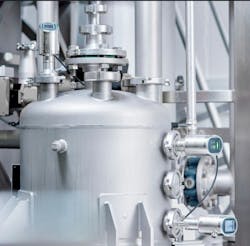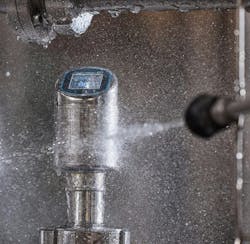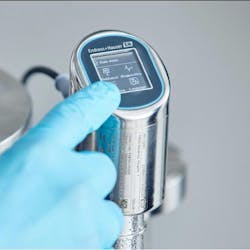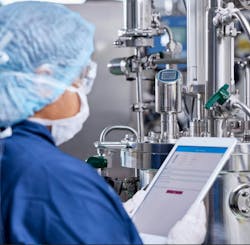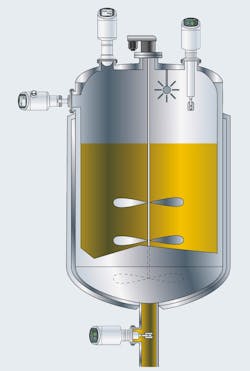Simplify device management with compact smart instrumentation
Throughout industry, process manufacturers are increasingly adopting smart instrumentation to leverage digital technologies that increase plant productivity and profitability. However, as different technologies proliferate across facilities, managing instrumentation fleets becomes more challenging.
Manufacturers with hygienic processes are seeking more versatile and efficient instrumentation to meet their unique application and sanitary requirements, in addition to the universal challenges shared with other industries. Faced with the limitations of conventional and/or non-standardized installed instrumentation bases throughout facilities, reliable and flexible solutions are needed.
Conventional limitations
Conventional analog instruments come in a vast array of shapes and sizes, each consisting of a measuring sensor and transmitter — sometimes as separate devices and other times combined — to communicate a process value to a host, such as a control or asset management system. These devices have leveraged universal 4-20mA signals for decades, and the challenges that come along with accessing their diagnostic data can hinder calibration, troubleshooting and maintenance. This becomes a larger matter with instruments in confined areas, as well as in applications with strict hygienic requirements, which are especially common in the food and beverage and biopharmaceutical sectors.
Furthermore, operations in these types of environments often have complex process conditions, including rapid changes in temperature, pressure, dielectric constant, conductivity, viscosity or density. Many robust traditional instruments are too large to fit in tight spaces or unsuitable for hygienic applications, while compact and hygienic devices may compromise measurement accuracy and performance.
Additionally, process anomalies — such as contaminant buildup or foam formation — can cause instrument malfunctions, resulting in costly process interruptions. These types of conditions are challenging to detect with conventional instruments that only transmit a single process value, requiring more frequent inspection and calibration to ensure continued process performance.
Calibration is often labor-intensive and expensive, requiring device removal and reinstallation, which can expose plant personnel to toxins or carcinogens in certain applications. Sometimes the unit under test must also be shipped to an accredited calibration facility, incurring additional expense, time and inconvenience.
Small devices with powerful capabilities
Capable and compact modern instruments address these and other challenges, developed to aid facility-wide standardization. Recent advances in this space include radar instrumentation for non-contact and continuous level measurement, vibronic point level switches and pressure measurement instruments, each built with the sensor and transmitter components housed in a single device. These hygienic and smart instruments provide reliable performance and advanced capabilities in a compact package, making them ideal for use in small vessels, pipes and other tight spaces, but they are also well-suited to standard areas.
This versatility enables standardization throughout a facility, which reduces maintenance costs, eases training, enhances scalability and promotes operational excellence by empowering plant personnel to specialize in a narrower range of instrument models. Furthermore, gap-free and fully welded stainless steel construction facilitates efficient cleaning and sterilization, earning these instruments hygienic ratings. As a result, these devices can remain in service during clean-in-place (CIP) and steam-in-place (SIP) procedures, minimizing manual cleaning efforts and the associated risk of contamination (Figure 1).
Leading devices include a high-visibility color display with intuitive touch operation, along with LEDs that indicate status and device health from a distance (Figure 2). User interface standardization further simplifies installation, training and operation, while digital wizards guide users through commissioning, parameterization and maintenance. These capabilities save time and reduce the likelihood of errors during configuration, without the need to enlist specialists.
Additionally, technicians can lock critical parameters to preserve configuration integrity, reinforcing process safety and ensuring product quality. Distinct user roles and permissions can be assigned for granular access control, bolstering device security and measurement accountability.
Compact instrument measurement principles
Free space radar sensors, like the Micropilot FMR43, provide reliable contactless level measurement, even in the presence of turbulent process conditions. The sensor is installed atop a process vessel, and it produces electromagnetic waves that reflect off the media surface. The device calculates the distance between itself and the media based on the time elapsed between emission and receipt of each wave, known as the time-of-flight. The measured distance is then used in conjunction with the known tank height to calculate level.
A vibronic point level switch, such as the Liquiphant FTL43, invokes an excitation within a tuning fork at its resonant frequency. When the tuning fork contacts liquid, the resonant frequency changes, signaling level exceedance. Vibronic point level detection is unaffected by physical properties — including conductivity, dielectric constant, density, pressure, temperature, turbulence, foam formation and bubbling — making it a reliable option for a wide variety of applications and process media.
Most pressure sensors, including the Cerabar PMP43, can be used to measure absolute or gauge pressure. Absolute pressure refers to the pressure of the process media relative to vacuum, while gauge pressure measures relative to ambient air pressure. The PMP43 can also be used to calculate the level in a vessel by measuring hydrostatic pressure, the force exerted by a liquid column due to gravity. As liquid height rises within a tank, the pressure at the bottom increases proportionally.
Automated verification and digital connectivity
Leading compact instrumentation employs state-of-the-art technology for continuous monitoring and on-demand device health verification, without requiring disassembly or process interruptions. For example, the Micropilot FMR43 radar level sensor uses a Radar Accuracy Index value, which can preemptively identify measurement performance outside of factory specifications that might require maintenance or calibration.
Additional monitoring capabilities can detect and alert personnel of developing process anomalies, including foam formation and buildup, reducing the risk of unplanned shutdowns. These types of signals are digitally communicated to hosts — providing nearly limitless datapoints for transmission. Collectively, these diagnostic technologies allow facilities to extend calibration and maintenance intervals, reducing downtime and maintenance expenses.
Furthermore, digital protocols empower operators to access instruments wirelessly and run automated device verification procedures via Bluetooth from any capable smartphone or tablet (Figure 3). Meanwhile, IO-Link and HART protocols provide increased application capabilities for entire host systems.
Hygienic use cases
Automated CIP procedures are common throughout the hygienic industries — particularly the food and beverage and life sciences sectors — and demonstrate key uses for these compact instruments. These systems circulate water, steam and cleaning agents throughout process lines to sterilize pipes, tanks and instrumentation without disassembly.
Before circulation, cleaning agents must be strategically combined in a mixing tank. This mixture contains chemicals of varying density, so hydrostatic pressure measurement is inadequate for assessing level. Instead, processors can use the Endress+Hauser FMR43 compact radar level sensor, which provides continuous and accurate level measurement independent of density, even in the presence of foam or condensate.
Alongside the radar sensor, the Liquiphant FTL43 compact point level switches are useful during chemical addition and mixing to prevent tank overfill with a high-level installation location, and dry run with a low-level installation location. As cleaning agents circulate throughout process lines, system pressure can be regulated at various points using measurements from the Cerabar PMP43 compact pressure instrument.
In biopharmaceutical processes, bioreactors are commonly employed to cultivate cells and microorganisms used to produce drugs, medications and vaccines. These vessels are designed to maintain optimal organic growth conditions, which requires consistent level and pressure control. In this application, a radar level sensor provides reliable measurement, even in turbulent or foaming conditions, while point level sensors prevent overfill and dry run in the bioreactor. Meanwhile, the pressure sensor provides continuous feedback to the host control system for any process adjustments as necessary (Figure 4).
Leveraging digital protocols, these instruments also provide both process and instrument diagnostic information to host systems, empowering users to monitor overall system health and proactively address developing issues before failures occur.
Small but mighty
Modern compact and capable hygienic instruments provide processors with numerous advantages — including application versatility, measurement reliability, robust design, maintenance-friendly diagnostic data, elevated operator safety and improved plant efficiency — in challenging applications.
With a small footprint and outsized performance, these devices provide the flexibility needed for standardization over a wide breadth of applications, regardless of spatial constraints. Empowered by consistency, ease-of-maintenance and scalability capabilities, processors can increase plant productivity and profitability, helping them keep a competitive edge in fast-paced industrial markets for decades to come.
About the Author
Ashley David
Product marketing manager for Endress+Hauser
Ashley David is a product marketing manager for Endress+Hauser. She is currently focused on providing strategic vision, leadership and marketing direction of Endress+Hauser level + pressure products, as well as leading and managing the development of business portfolio launch concepts and business marketing plans. Previously, David has served as a regional business driver specializing in pressure, temperature and system products for Endress+Hauser. She also spent time working in technical support and application engineering, creating expertise in customer processes and manufacturing.
